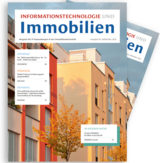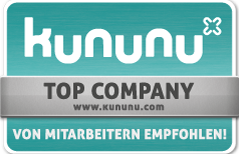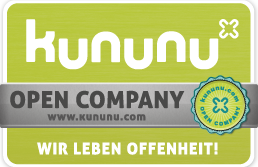ERP systems in the real estate industry – Interview with Thoralf Beyer and Thomas Brösicke

For five years now, PROMOS consult has supported companies in the real estate and housing industry with the introduction of, or conversion of their SAP® system to, the new S/4HANA® release. The digitisation experts are now fast approaching their 30th project. Anyone who’s been involved in a conversion knows how much hard work is involved. Meanwhile, those facing a first-time implementation may be worried about the project scope and challenges ahead. No matter where you are in your transformation journey, the ERP system – the beating heart of the company – is always affected. Drawing on 25 years of experience in the real estate industry and more than 20 years with SAP® standard software, PROMOS consult is well acquainted with all of these concerns.
IT&I: Mr Beyer, you head the strategic sales department at PROMOS consult and regularly talk to potential customers. What are the requirements of companies in the real estate sector from an ERP system?
Thoralf Beyer: First and foremost, anyone looking for an ERP system is looking for a digital core to incorporate all company processes and also form a basis for their own company’s digital transformation. An ERP system therefore needs to have the appropriate range of functions that our customers require for professional real estate management. First, these functions should include applications that address traditional administrative tasks: from accounting, through to sector-specific activities such as condition adjustments, regular execution of the debit position or preparation of the operating cost statement, and, depending on the business model, tasks such as letting, sales or construction. For example, if I as a company invest in building my own properties, I need functions for construction project management. Suppliers need to be controlled, services accepted, warranty deadlines met, and so on. The requirements for the scope of functions can therefore vary and sometimes appear complex. With this in mind, the software must be easy for the user to learn and operate. However, the concept of a digital core also includes the requirement for a technology and infrastructure that offers the flexibility needed to digitise my business processes, seamlessly integrate all user groups and thus achieve optimal networking. This is the only way to really boost efficiency. And it is the primary goal when using an ERP system.
IT&I: Has it always been like this or has anything changed?
Beyer: Creating efficiency is not a new requirement for an ERP system. However, the approach has changed. Companies neither want nor can afford to spend time on lengthy implementation projects in which the solution’s scope is laboriously set out and described, point by point, in concept papers. Many companies opt for a standard version that focuses on the basic essentials in order to speed up the implementation process. Users can therefore quickly come into contact with the system, use best practices and integrate additional specialised applications or adjustments at a later stage based on their experience with the system. In this scenario, the customer sets the pace of innovation. Introducing an ERP system in this way increases acceptance among employees. The quicker employees see a reduction in their workload thanks to fast processes and ease of use, the more willing they will be to use the new working process. They may also want to contribute to future-oriented, innovative concepts themselves.
All of these factors – a standard system, documentation, intuitive user interfaces and elimination of individualised processes – can make the induction of new employees much easier and thus reduce knowledge loss when change happens.
IT&I: How does PROMOS consult address changing requirements?
Beyer: With PROMOS.GT ready2, we offer a precise fit for these market requirements and a template to get you up and running quickly. Our extensive PROMOS.GT solution library now comes with a little brother, which provides a preconfigured SAP® system in the form of a template or blueprint for fast implementation. It’s an out-of-the-box, ready-to-use solution for the real estate industry.
In other words, companies get a predefined and preconfigured system that draws on 25 years of experience in the real estate industry and covers all the important functional modules they need for their real estate management. These include general ledger and asset accounting, modules for payment transactions and tax, rental accounting, deposit management and contract files, as well as modules for maintenance processing, mobile defect recording and much more. The basic package excludes functions that are not essential for the core business. However, these can freely be added in subsequent expansion stages. Such stages could include a tenant or prospective tenant app, a craftsmen portal or our mobile solution for quality management and legal safety regulations. We have a well-stocked portfolio in this area.
IT&I: Mr Brösicke, PROMOS.GT ready2 is based entirely on SAP® technology. Why is this the best approach, in your view?
Thomas Brösicke: Well, is there is anyone out there who hasn’t heard of SAP? Certainly anyone working in the IT field has come across those three letters. In terms of revenue, Europe’s largest software manufacturer is on a sound footing, which means that investment in SAP® is secure in the long term. This applies not only to investors and shareholders, but also to companies that use their software. Customers who choose SAP® today can rely on a maintenance commitment for their ERP system for at least another 20 years. So long-term security is definitely one of the reasons. In addition, the systems are based on the latest technology, allowing customers to benefit from access to the latest innovations from SAP that are also in use in other industries and the world’s largest corporations – without having to invest in development efforts themselves. The third and perhaps most important reason why PROMOS also followed this path many years ago is the flexibility offered by SAP software. There’s no other comparable product as suitable for individual customisation to the particular requirements of business transactions – if that’s what you want. It’s up to the individual company to decide whether to start with just a few standardised functions and then gradually expand them after the introduction. Customising capability and scalability in size are guaranteed.
IT&I: Who is the solution suitable for? Should smaller companies also consider investing in SAP®?
Brösicke: Definitely. Of course it always depends somewhat on the company’s requirements. But from about 3,000 managed units upwards, the requirements for administration are often so extensive that simple administration software is no longer enough. On top of that, necessary functions are either not available at all, barely accessible, or inefficient because many other additional programs are needed and the data is stuck in multiple silos. Our PROMOS.GT ready2 is particularly suitable for smaller and medium-sized companies with limited specialist IT resources and modest customising requirements. The system is suitable for all sectors of the industry: housing associations, municipal companies or property management companies.
To come back to a point Thoralf mentioned earlier, the human factor also plays an essential role. If you’re in a company that uses cumbersome systems and outdated user interfaces, it’s difficult to recruit and train new professionals. As we’ve established: SAP is widely used in Germany and Europe. The chances of finding new employees who are familiar with SAP systems are very high – for users as well as key users and IT staff. Long training periods can thus be avoided.
IT&I: How long does it usually take to introduce an ERP system and to what extent does the project approach affect the go-live?
Brösicke: It depends. The system itself can be made available in two to three weeks. Taking training, data transfers and modifications into account, the total duration is about three to six months. Since the degree of customisation has a considerable influence on the duration of the project, we recommend that companies who want to get up and running quickly implement our preconfigured standard version first. You can still add useful enhancements and modifications, even after going live. Thoralf has already described the advantages in detail [laughs].
IT&I: You refer to a standard system, but not all processes are the same in every company. How do you strike the right balance between standardisation and customisation?
Brösicke: The SAP® system as a whole is one of the most flexible, cross-industry ERP systems. One of SAP’s great strengths is that almost any customer requirement can be developed and implemented. This is the real reason why SAP® projects are often wrongly perceived as lengthy and expensive. Many companies, irrespective of sector, have very individual ideas and requirements that need to be adapted and implemented in the system. This increases the overall effort required, but SAP provides the technology to make it possible in the first place. The challenge for us is to create a standard system that also leverages the basic principle of flexibility.
Beyer: Thanks to our years of experience in the real estate industry and the multitude of projects we’ve carried out for our customers in that time, we’ve become experts in assessing what our customers in the housing industry need. The Pareto principle or 80:20 rule also applies in this case: A large portion of the requirements are the same or similar, such as types of contracts, conditions, damage patterns and defects or charts of accounts and much more. These contents are standardised in PROMOS.GT ready2 and preconfigured in the SAP® system at the time of delivery. For processes, on the other hand, we have developed best practices that often fit the bill, but that can of course also be individually adapted. All additional requirements can be flexibly adapted either before or after the go-live phase depending on the customer’s requirements and level of urgency.
Brösicke [nods]: We’ve created a template that enables rapid delivery and a short project runtime to significantly reduce the implementation effort, all while still offering customisation. A customisable standard system, if you like.
IT&I: To conclude: What advice would you give to companies looking for an ERP system?
Beyer: Think about the long term! For the current version, SAP is offering a maintenance commitment until 2040. Anything else?
Brösicke: Yes. Don’t just look for a service provider for the implementation project – look for a partner!
IT&I: Thank you for the interview.
redaktion@openpromos.de




